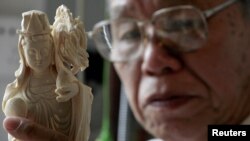An International Fund for Animal Welfare report has linked the increasing number of elephants being killed in Africa with the rising demand for ivory in China.
According to the report, in 2011 poachers gathered more than 5,200 elephant tusks, (23 tons) resulting in the deaths of more than 2,500 elephants. It says the majority of that ivory went to China.
“The growing demand for ivory products in China is actually driving elephant poaching across Africa," explained Elizabeth Wamba, communications manager for the International Fund for Animal Welfare in Eastern Africa. "It has just been too high. It has escalated by, in some places, in hundreds of percentages.”
The report quotes an auction newsletter describing the 2011 sale of more than 11,000 ivory pieces in mainland China for a total of $95.4 million, an increase of 107 percent from the previous year.
The report says the price for ivory has soared, but a strengthened Chinese currency against the U.S. dollar makes it more profitable for Chinese buyers to purchase ivory on world markets.
The report attributes the rising demand to the legal sale of ivory stockpiles in China and Japan in 2008. The stockpiles originated from South Africa , Zimbabwe, Namibia, and Botswana.
China Central Television reported that regular investors are viewing ivory products as being “white gold.”
The report says China introduced a system in 2004 to control the domestic ivory market in line with the Convention on the International Trade in Endangered Species, but regulation is virtually non-existent.
Of the 158 ivory trade facilities surveyed by Chinese experts in five cities, 101 were operating illegally, not having any government-issued licenses.
Nairobi-based wildlife trade expert Esmond Martin has done extensive research on the ivory trade. He told VOA research he conducted in two Chinese provinces last year revealed about 62 percent of the ivory for retail sale did not have the proper documents.
He said much of China’s illegal ivory originates from African countries in which large numbers of Chinese expatriates purchase carvings, jewelry and other items made out of ivory and smuggle them back into China.
“And then you have got the large quantities of ivory being shipped out of Africa, most of it now through East African ports that mostly goes by ship," said Martin. "And it goes to various Asian countries on the way. They look at various countries where they think it is easy to move stuff out.”
Martin said that because there is a certain amount of ivory that is sold legally in China, it is very difficult to determine the difference between legal and illegal ivory goods.
According to the report, in 2011 poachers gathered more than 5,200 elephant tusks, (23 tons) resulting in the deaths of more than 2,500 elephants. It says the majority of that ivory went to China.
“The growing demand for ivory products in China is actually driving elephant poaching across Africa," explained Elizabeth Wamba, communications manager for the International Fund for Animal Welfare in Eastern Africa. "It has just been too high. It has escalated by, in some places, in hundreds of percentages.”
The report quotes an auction newsletter describing the 2011 sale of more than 11,000 ivory pieces in mainland China for a total of $95.4 million, an increase of 107 percent from the previous year.
The report says the price for ivory has soared, but a strengthened Chinese currency against the U.S. dollar makes it more profitable for Chinese buyers to purchase ivory on world markets.
The report attributes the rising demand to the legal sale of ivory stockpiles in China and Japan in 2008. The stockpiles originated from South Africa , Zimbabwe, Namibia, and Botswana.
China Central Television reported that regular investors are viewing ivory products as being “white gold.”
The report says China introduced a system in 2004 to control the domestic ivory market in line with the Convention on the International Trade in Endangered Species, but regulation is virtually non-existent.
Of the 158 ivory trade facilities surveyed by Chinese experts in five cities, 101 were operating illegally, not having any government-issued licenses.
Nairobi-based wildlife trade expert Esmond Martin has done extensive research on the ivory trade. He told VOA research he conducted in two Chinese provinces last year revealed about 62 percent of the ivory for retail sale did not have the proper documents.
He said much of China’s illegal ivory originates from African countries in which large numbers of Chinese expatriates purchase carvings, jewelry and other items made out of ivory and smuggle them back into China.
“And then you have got the large quantities of ivory being shipped out of Africa, most of it now through East African ports that mostly goes by ship," said Martin. "And it goes to various Asian countries on the way. They look at various countries where they think it is easy to move stuff out.”
Martin said that because there is a certain amount of ivory that is sold legally in China, it is very difficult to determine the difference between legal and illegal ivory goods.








